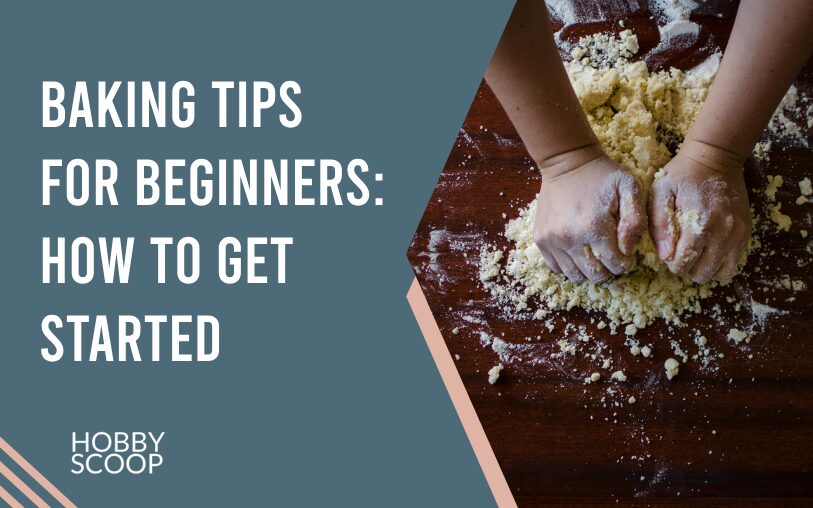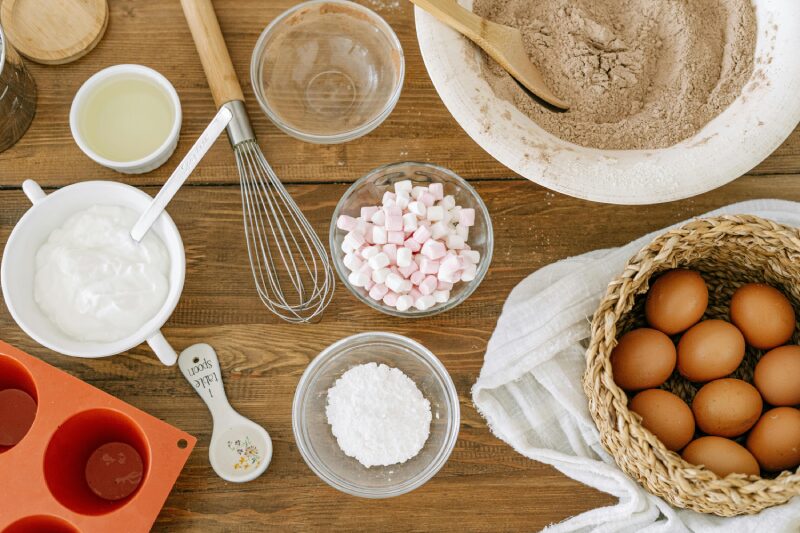Hey there, new baker! Ready to dive into the wonderful world of baking? Whether you’re dreaming of making the perfect loaf of bread or the chewiest cookies, you’re in for a fun ride.
Baking is a bit like a magic show, where simple ingredients come together to create something amazing. Let’s walk through some baking tips for beginners that’ll help you start your baking adventure on the right foot.

Back to Basics: Baking 101
Think of baking as a friendly science experiment. Understanding the role of each ingredient and the importance of precision can transform your baking from good to great.
Measuring Matters
In baking, accuracy isn’t just important; it’s everything. Eyeballing ingredients can turn your fluffy cake into a brick and your cookies into pancakes.
- Scale vs. Cups: While measuring cups can work, a digital scale is a game-changer, offering precision that cups can’t match. For example, a cup of flour can vary in weight depending on how you scoop it, but 120 grams of flour is always 120 grams.
- Liquid vs. Dry Measuring Cups: Use liquid measuring cups for liquids and dry cups for dry ingredients. The meniscus (the curve at the top of the liquid) can throw off your measurements if you’re using the wrong type of cup.
- Spoons for Smaller Measurements: When it comes to baking powder, baking soda, salt, and spices, even a little extra can have a big impact. Ensure you’re using the exact amount by leveling off your measuring spoons.
Room Temperature is the Secret
Ingredients at the right temperature mix better, creating a uniform texture in your baked goods.
- Butter: Softened butter should yield slightly to pressure but still hold its shape. This makes it ideal for creaming with sugar to create a light, fluffy base for cakes and cookies.
- Eggs: Room-temperature eggs disperse more evenly into your batter, aiding in a more uniform structure and better rise. To quickly bring eggs to room temperature, place them in a bowl of warm water for about 10 minutes.
- Dairy: Ingredients like milk and yogurt should also be at room temperature to prevent re-solidifying melted butter in a batter, ensuring a smooth mix.

Picking Your Tools
The right tools don’t just make baking easier; they can improve the quality of your baked goods. Here’s a more detailed look at the essentials.
The Essentials
- Mixing Bowls: Have a range of sizes for different tasks. A large bowl for mixing doughs and batters, and smaller ones for beating eggs or combining dry ingredients.
- Spatulas and Whisks: Silicone spatulas are great for scraping every last bit of batter from a bowl, while whisks are essential for mixing dry ingredients or aerating liquids.
- Baking Pans and Sheets: Quality matters. Dark pans can cause your baked goods to brown too quickly, while light-colored pans reflect heat, promoting even baking. Consider investing in a variety of sizes and shapes to match your baking needs.
- Parchment Paper or Silicone Mats: These can be lifesavers for preventing sticking and ensuring easy cleanup. They’re particularly useful for cookie baking and candy making.
Know Your Oven
Ovens are notoriously finicky, but understanding yours can lead to consistently better bakes.
- Hot Spots: Most ovens have them. To find yours, bake a sheet of cookies and see which ones brown fastest. Once you know, you can rotate your pans for even baking.
- Calibration: An oven thermometer is invaluable. Your oven’s dial might say 350°F, but the actual temperature could be off by 10-30 degrees or more. Regularly check your oven’s temperature to ensure it’s accurate.
- Preheating: Essential for proper rise and texture. Place an oven thermometer inside, preheat your oven, and check if it reaches the desired temperature before you start baking.
By deepening your understanding of these basic principles and tools, you’re setting yourself up for success in the kitchen. Remember, every great baker started with the basics, and mastering these is your first step toward baking mastery.
Navigating Oven Temperatures: Making Sense of the Heat
Getting the temperature right is like hitting the sweet spot in baking. Whether you’re dealing with a recipe from across the globe or figuring out your oven’s quirks, understanding oven temperatures can make or break your baking game. Let’s break it down into bite-sized pieces.
Celsius and Fahrenheit: The Oven Temperature Language
Ovens can speak in Celsius (°C) or Fahrenheit (°F), depending on where you are or where your recipe comes from. Instead of wrestling with math to convert between them, here’s a handy cheat sheet for some common baking temperatures:
| Celsius (°C) | Fahrenheit (°F) |
|---|---|
| 150°C | 300°F |
| 180°C | 350°F |
| 190°C | 375°F |
| 200°C | 400°F |
| 220°C | 425°F |
Keep this table nearby, and you’ll be a temperature translation whiz in no time!
Fan-Forced vs. Conventional Ovens: The Great Debate
Ovens come in two main flavors: fan-forced (also known as convection) and conventional. Knowing which one you’re working with can make a big difference in your baking.
- Fan-Forced Ovens: These ovens use a fan to circulate hot air, baking things a bit quicker and more evenly. If a recipe doesn’t say “fan-forced,” you might want to lower the temperature by about 20°C (or roughly 35°F) to avoid overbaking.
- Conventional Ovens: These are your straightforward, no-fan-involved ovens. They’re the default setting for most recipes, but you might need to rotate your baking tray halfway through to get even browning.
Top Tips for Temperature Triumphs
- Preheating is Key: Just like you wouldn’t jump into a cold pool, don’t put your treats into a cold oven. Preheat it to the right temperature before your goodies go in.
- Trust, but Verify: Oven dials can be misleading. An oven thermometer is a baker’s best friend, giving you the real scoop on what’s happening inside your oven.
- Keep it Closed: Resist the temptation to open the oven door too often. Peek through the window instead. Every time you open the door, you let out heat and can mess with your bake time.
Let’s Get Baking: Starting Simple
Don’t jump into the deep end with a five-tier wedding cake. Start with something a bit more forgiving.
- Beginner-Friendly Recipes: Cookies, simple cakes, or muffins are great starting points. They’ll teach you the basics without too much stress.
- Read Before You Bake: Always read the recipe through before you start. It’ll help you avoid surprises and make sure you have everything you need.
Experiment with Flavors and Ingredients
Once you’ve nailed the basics, why not spice things up a bit? Baking is not just about following recipes to the letter; it’s also about putting your twist on things.
- Mix and Match: Try adding different spices, nuts, or fruits to your recipes. Imagine a dash of cinnamon in your chocolate chip cookies or some orange zest in your brownies. The possibilities are endless!
- Substitute Smartly: Playing around with ingredients can lead to delightful surprises. Swap out regular flour with almond flour for a nutty flavor, or replace some sugar with honey for a new taste texture. Just keep in mind that some ingredients interact differently, so changes might affect the outcome.
Personal Touches Make Perfect
- Picture this: You’re making your favorite brownie recipe, but this time, you decide to swirl in some peanut butter before baking. The result? A delicious twist on a classic that’s uniquely yours. Experimenting can lead to your next signature dish!
Timing is Everything
Baking isn’t just about what you do; it’s also about when you do it. Understanding the timing can make a huge difference in your baking results.
- Don’t Rush the Process: Good things take time. Rushing your dough to rise or not chilling your pastry can lead to less-than-stellar results. Patience is a virtue in the kitchen.
- Baking Time: Keep an eye on your oven. Baking times can vary based on a lot of factors, like your pan’s material or your oven’s quirks. Start checking on your baked goods a few minutes before the recipe suggests, just to be safe.
Quick Timing Tip
- If you’re baking cookies, for example, they’ll continue to cook on the baking sheet after you take them out of the oven. So, if you prefer your cookies soft and chewy, pull them out when they’re just set but still look a tad undercooked in the middle.
Presentation Matters
You eat with your eyes first, they say, and it’s true! Making your baked goods look as good as they taste is part of the fun of baking.
- Get Creative with Decoration: A simple drizzle of glaze, a dusting of powdered sugar, or some colorful sprinkles can turn a plain cake into a feast for the eyes.
- Serve with Style: Think about how you’re serving your baked creations. A nicely plated slice of cake or a stack of cookies can make all the difference in how they’re received.
A Simple Decoration Idea
- Imagine you’ve made a batch of cupcakes. Instead of just slathering on the frosting, try using a piping bag with a star tip to add a professional-looking swirl. Top it off with a single raspberry, and voila! You’ve got a treat that looks as tempting as it tastes.
Oops! Baking Boo-Boos
Everyone makes mistakes, especially when you’re just starting out. The key is to learn from them.
- Troubleshooting: If your cake sinks in the middle or your cookies spread too much, don’t stress. It’s all part of the learning process. A quick internet search can usually tell you what went wrong and how to fix it next time.
- Ingredient Swaps: Out of an ingredient? Before you dash to the store, check if there’s a substitute you can use. No eggs? Applesauce or mashed bananas might work in a pinch.
Your Baking Journey
Baking is a skill, and like any skill, it gets better with practice. So, roll up your sleeves, get your hands a little floury, and most importantly, have fun with it! There’s nothing like the smell of fresh-baked cookies to make your kitchen feel like home. And remember, every baker started where you are now. Happy baking!